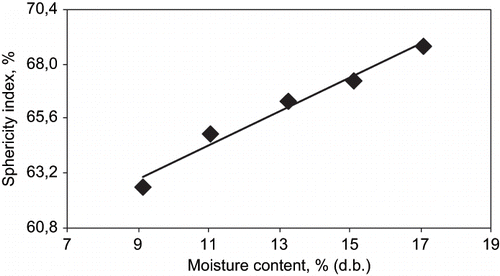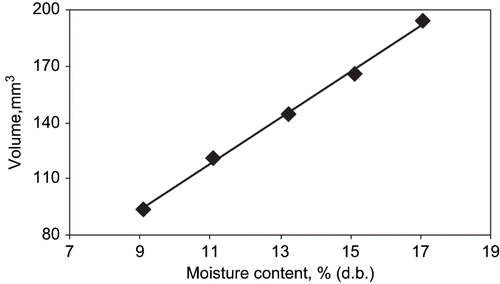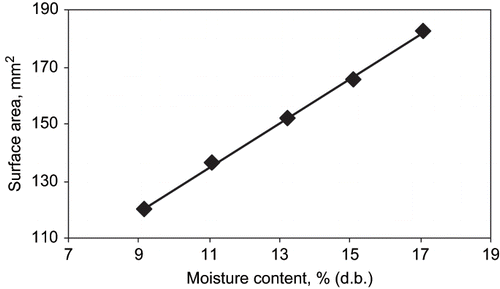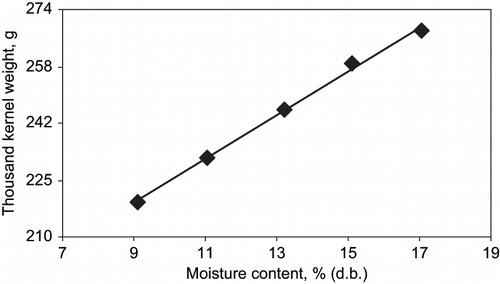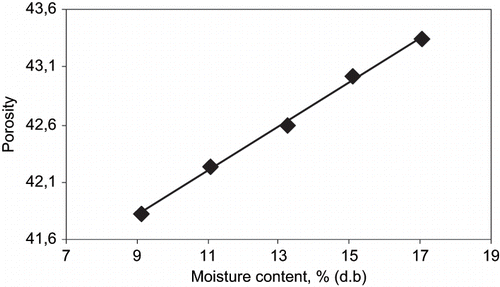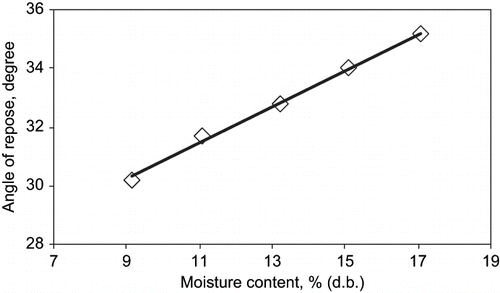Abstract
Physical properties of sweet corn kernels have been evaluated as a function of kernel moisture content, varying from 9.12 to 17.06% (db). In the moisture range, kernel length, width, thickness, and geometric mean diameter increased linearly from 9.87 to11.09 mm, 7.41 to 9.25 mm, 3.25 to 4.37 mm, and 6.18 to 7.62 mm, respectively, with increase in moisture content from 9.12–17.06%. The sphericity index, kernel volume, kernel surface area, and thousand seed weight increased linearly from 62.6 to 68.8, 93.8 to 194.3 mm3, 120.1 to 182.9 mm2, and 220 to 268 gr, respectively. Apparent density and bulk density decreased linearly from 1.315 to 1.232 g/cm3 and 0.765 to 0.698 g/cm3, respectively, while bulk porosity increased from 41.8 to 43.3%. The highest static coefficient of friction was found on the plywood surface. The static coefficient of friction increased from 0.680 to 0.891, 0.605 to 0.741, and 0.530 to 0.644 for plywood, galvanized iron, and aluminum surfaces, respectively. The angle of repose increased linearly from 30.2 to 35.2° with the increase of moisture content.
INTRODUCTION
Sweet corn (also known as sugar corn), is a hybridized variety of maize (Zea mays), specifically bred to increase the sugar content,[Citation1] and it is one of the most popular vegetables in the United States and Canada. Consumption is increasing in eastern Asia, Europe, and South America.[Citation2] The specific time when sweet corn originated cannot be pin-pointed; however, sweet corn was grown by the American Indian and first collected by European settlers in the 1770s.[Citation3] Sweet corn is commonly eaten as a vegetable, rather than a grain. The kernels are boiled or steamed to produce canned sweet corn and eaten as a side dish. Sweet corn may also be eaten in its dry grain form. If left to dry on the plant, kernels may be taken off the cob and cooked with popcorn. Sweet corn does not pop like popcorn, but expands to about double the original kernel size.[Citation1] In Turkey, sweet corn production and consumption values are underestimated. However, nowadays production and consumption of sweet corn are showed increasing trends.[Citation4] Various physical properties of seeds, grains, and kernels are dependent on moisture content, and appear to be important in the design of planting, harvesting, handling operation, transportation, storing, and processing equipment. In this study, moisture dependent selected mass-volume-area properties of dry sweet corn kernels, namely, linear dimensions, geometric mean diameter, kernel volume, kernel surface area, thousand kernels weight, apparent density, bulk density, porosity, angle of repose, and static coefficient of friction against three structural surfaces were investigated.
MATERIALS AND METHODS
Sample Preparation
The sun dried sweet corn kernels used in the present study were obtained from a crop grown during 2002 at West Mediterranean Agricultural Research Institute in Antalya. The kernels were manually cleaned to remove all foreign matter, broken, and immature kernels. Dried sweet corn kernels were conditioned by adding a calculated quantity of water, mixing thoroughly and then sealing in separate polyethylene bags. The samples were kept at 5°C in a refrigerator for 15 days for the moisture to distribute uniformly throughout the samples. Before each test, the required quantity of samples was taken out of refrigerator and allowed to warm up to room temperature. All the physical properties were determined at the moisture contents of 9.12, 11.08, 13.24, 15.11, and 17.06% (db). Moisture content of the sweet corns was determined by oven drying at 103°C to reach constant weight (3 h).
Determination of Physical Properties
To determine the size of sweet corn kernel, a sample of hundred kernels was randomly selected. The three major perpendicular dimensions of the sweet corn kernels namely length (L), width (W), and thickness (T) were measured using a digital caliper reading to 0.01. The geometric mean diameter Dg of the seed was calculated by using the following relationship:[Citation5]
where L is the length, W is the width and T is the thickness in mm. The sphericity index value (Φ) of sweet corn kernels is calculated using the following formula:[Citation5]
Jain and Bal[Citation6] have stated kernel volume, V and kernel surface area, S may be given by:
Apparent density defined as the ratio of mass of the sample to its kernel volume, was determined using the water displacement method. Five hundred milliliter of water was placed in a 1000 ml graduated measuring cylinder and 25 g seeds were immersed in that water. Owing to the short duration of the experiment and the nature of the skin of the kernel, which did not allow water to be absorbed easily, the kernels were not coated to prevent moisture adsorption. The amount of displaced water was recorded from the graduated scale of the cylinder. The ratio of weight of seeds to the volume of displaced water gave the kernel apparent density.[Citation11,Citation12]
Bulk porosity of bulk kernel was computed from the values of kernel apparent density and bulk density using the relationship given by Mohsenin[Citation5] as follows:
where ρ b is the bulk density and ρ app is the apparent density. The coefficient of static friction was determined with respect to three surfaces: plywood (μ p ), galvanized iron sheet (μ g ) and aluminum sheet (μ a ). These are common materials used for handling and processing of grains and construction of storage and drying bins. A hollow metal cylinder 50 mm diameter and 50 mm high and open at both ends was filled with the seeds at the desired moisture content and placed on an adjustable tilting table such that the metal cylinder does not touch the table surface. The tilting surface was raised gradually by means of a screw device until the cylinder just starts to slide down. The angle of the surface was read from a scale and the static coefficient of friction was taken as the tangent of this angle. Other researchers have used this method for other grains and seeds.[Citation13–16]
To determine the dynamic angle of repose (θ), a plywood box measuring 300 mm × 300 mm × 300 mm, having a removable front panel was used. The box was filled with the seeds at the desired moisture content, and the front panel was quickly removed, allowing the seeds to flow to their natural slope. The angle of repose was calculated from measurements of seed free surface depths at the end of the box and midway along the sloped surface and horizontal distance from the end of the box to this midpoint. This method has been used by other researchers.[Citation6,Citation13,Citation15,Citation17] The angle of repose may also be determined from the diameter and height of a heap of seeds on a circular plate.[Citation18] All the experiments were replicated 5 times for each sweet corn samples, and the average values were reported.
RESULTS AND DISCUSSION
Dimensional properties (length, width, thickness, geometric mean diameter, sphericity index, volume), mass and bulk properties (1000 kernel weight, bulk and true densities, porosity, angle of repose) and static coefficient of friction values of sweet corn kernels at the different moisture content are presented in , , and , respectively.
Table 1 Length, width, thickness, geometric mean diameter, sphericity index, surface area, and volume of sweet corn kernels at different moisture
Table 2 Thousand kernel weight, bulk density, apparent density, porosity, and angle of repose of sweet corn kernels at different moisture content
Table 3 Static coefficient of friction of sweet corn kernels on various surfaces at different moisture content
Kernel Dimensions
All the dimensions increased with the increase of kernel moisture content. For the increase of moisture contents from 9.12 to 17.06 % (d.b.), the increase of length, width, thickness, and geometric mean diameter were, 12.36, 24.83, 34.46, and 23.30%, respectively. The total average expansion, from 9.12 to 17.06% (d.b.) kernel moisture content was the largest along the kernel thickness in comparison with their other principal axes. Deshpande et al.[Citation8] have been reported similar results with soybeans. The geometric mean diameter was higher than the thickness of sweet corn kernel. Similar results reported for millet,[Citation6] locust bean,[Citation19] sakiz faba bean,[Citation20] and popcorn kernel.[Citation21]
The relationships between the axial dimensions (L, W, and T) and kernel moisture content (Mc ) can be expressed using the regression equations as:
Sphericity Index
The relationship between sphericity index and moisture content of sweet corn kernels are shown in . The values of the sphericity for different moisture levels decreased linearly from 62.6 to 68.8. This relationship of sphericity index (%) can be represented by the following equation:
The sphericity index of sweet corn kernels was much higher than these reported for safflower.[Citation22] However, it was lower than those reported for chickpea,[Citation9] popcorn,[Citation21] millet,[Citation23] hazelnut,[Citation24] cacao,[Citation25] rape seed,[Citation26] and pistachio kernel.[Citation27]
Kernel Volume
The volume (V) variations with kernel moisture content are shown in . The volume increased linearly with moisture content. When the moisture content changed from 9.12 to 17.06%, the volume increased from 93.84 mm3 to 194.30 mm.3 This relationship can be written as:
Similar results have been reported for popcorn,[Citation21] safflower,[Citation22] millet,[Citation23] rape seed,[Citation26] and white lupin.[Citation28]
Surface Area
The variation of sweet corn kernel surface area, S, with increasing moisture content is shown in . There is an approximately 52% increase in surface area from a moisture content of 9.12–17.06%. Karababa[Citation21] and Baryeh[Citation23] found a similar linear increasing trend with millet and popcorn kernel, respectively. The variation in surface area (mm2) with moisture content of sweet corn kernel can be represented by the following equation:
Thousand Kernel Weight
The thousand kernel weight increased linearly from 220 to 268 g increasing kernel moisture content (). The variation of thousand kernel weight (g) can be expressed by the following equation:
Similar results have been reported for popcorn,[Citation21] millet,[Citation23] cacao,[Citation25] rape seed,[Citation26] white lupin,[Citation28] coffee,[Citation29] and gram seed.[Citation30]
Bulk Density
The bulk density of the kernel was observed to decrease linearly from 765 to 698 kg/m3 as the moisture content increased from 9.12 to 17.06% (). The relationship of bulk density (kg/m3) can be expressed by the following equation:
Figure 5 Effect of moisture content on density of sweet corn. (⋄), apparent density; (□), bulk density.
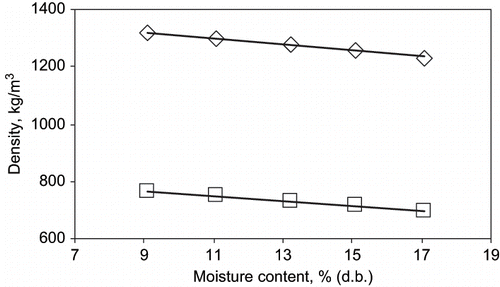
Apparent Density
Apparent density decreased linearly from 1315 to 1232 kg/m3 as the kernel moisture content increased (). The apparent density (kg/m3) of kernel can be represented by following equation:
This may be due to higher rate of increase in seed volume than weight. The negative linear relationship was also observed for chickpea,[Citation9] popcorn[Citation21] hazelnut,[Citation24] and gram seed.[Citation30] However, linear increasing trend was reported for sunflower,[Citation7] millet,[Citation23] cacao,[Citation25] pistachio,[Citation27] white lupin,[Citation28] coffee,[Citation29] and cashew nut.[Citation31]
Porosity
The porosity was calculated from the bulk density and apparent density of the kernel. The porosity was found to decrease from 41.83 to 43.34% with increase in moisture content from 9.12 to 17.06% (). The relationship between the porosity (%) and moisture content for sweet corn kernels can be represented by the following equation:
While most of the researcher was reported linear increasing trend for sunflower,[Citation7] chickpea,[Citation9] popcorn,[Citation21] millet,[Citation23] hazelnut,[Citation24] cacao,[Citation25] rape seed,[Citation26] white lupin,[Citation28] gram seed[Citation30] and cashew nut,[Citation31] decreasing trends was reported by Kashaninejad et al.[Citation27] and Chandrasekar and Viswanathan[Citation29] for coffee and pistachio. The values obtained were lower than those reported for sunflower kernels,[Citation7] chickpea,[Citation9] millet,[Citation23] hazelnut,[Citation24] raw cashew nut,[Citation31] and higher than those reported for cacao,[Citation25] white lupin,[Citation28] and gram.[Citation30] Similar results were reported for popcorn.[Citation21]
Static Coefficient of Friction
The plots of static coefficient of friction obtained experimentally on three structural surfaces against moisture content in the range of 9.12–17.06% (d.b) are displayed in . The static coefficient of friction varied significantly at 5% probability level. The relationship between moisture content and static coefficients of friction for three surfaces is presented in . The coefficient of friction of sweet corn kernel increased linearly with moisture content and varied according to the surface. Plywood had the highest coefficient of friction followed by galvanized iron and aluminum. This order has been reported by other researchers.[Citation14–16,Citation18,Citation32–34] On the other hand, Amin et al[Citation35] have been reported that no variances between plywood and galvanized iron sheet for pulse grains. Tunde-Akintunde and Olajide[Citation36] also reported that low coefficient of friction values on plywood for soybean as comparable to our results. This may be due to the smoother surface of galvanized iron compared to plywood, and the smoother surface of aluminum compared to galvanized iron. The sweet corn kernel also may become rougher and sliding characteristics are diminished at higher moisture contents, so that the static coefficient of friction increased.
Figure 7 Effect of moisture content on static coefficient of friction of sweet corn. (⋄), Plywood; (Δ), Galvanized iron; (○), Aluminum.
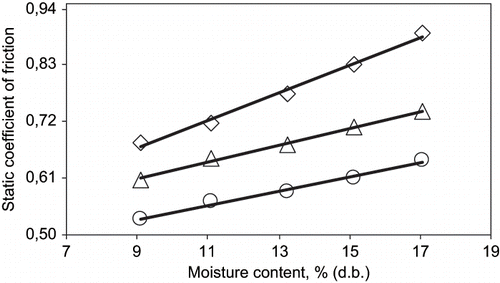
Table 4 The relationship between moisture content and static coefficients of friction for various surfaces.Footnote a
Angle of Repose
The variation of the angle of repose, θ with seed moisture content is plotted in . The angle of repose increases linearly with seed moisture content from 30.2 at 35.2 % seed moisture content to at 9.12 to 17.06% seed moisture content. The relationship of angle of repose (degree) can be expressed in equation form as follows:
The values of angle of repose were lower than those of millet,[Citation23] and coffee,[Citation29] but higher than that of chickpea.[Citation9] These differences could be due to differences in surface roughness of seeds. This could also be responsible for the increasing trend of the angle of repose at higher moisture contents. Also, Chowdhury et al.[Citation30] reported similar angle of repose values for gram.
CONCLUSIONS
The length, width, thickness, and geometric mean diameter of sweet corn kernels increased linearly with increase of moisture content. Sphericity, kernel volume, kernel surface area, and thousand kernel weights increased linearly with increase of moisture content. Apparent density was higher than bulk density at all kernel moisture contents studied. Kernel apparent and bulk density slightly decreased linearly with increase of moisture content but porosity increased with increase in moisture content. The static coefficients of friction was highest for plywood, followed by galvanized iron and aluminum among the material tested. Angle of repose increased from 30.2° to 35.2°, from kernel moisture content of 9.12–17.06%. The physical properties of sweet corn kernels were expressed in the linear regression equations as a function of moisture content. High correlation coefficients were found with a significance level of 95%.
REFERENCES
- Anonymous. http://en.wikipedia.org/wiki/Sweetcorn (Accessed: 27 June 2007 ).
- Tracey , W. 2000 . “ Sweet Corn ” . In Specialty Corns , Edited by: Hallauer , A.R. 155 – 188 . CRC Press LLC .
- Schultheis, J.R. Sweet Corn Production, Extension Horticultural Specialist Department of Horticultural Science North Carolina Cooperative Extension Service. North Carolina State University, 1998. http://www.ces.ncsu.edu/hil/hil-13.html (Accessed: 27 June 2007 ).
- Turgut , İ . 2000 . Bursa koşullarinda yetiştirilen şeker misirinda (Zea mays saccharata Sturt.) bitki sikliğinin ve azot dozlarinin taze koçan verimi ile verim öğeleri üzerine etkisi . Turk J Agric For. , 24 : 341 – 347 .
- Mohsenin , N.N. 1980 . “ Physical Properties of Plant and Animal Materials ” . In Gordon and Breach Science , 51 – 87 . New York : Publishers Inc .
- Jain , R.K. and Bal , S. 1997 . Properties of Pearl Millet . J. Agric. Eng. Res. , 66 : 85 – 91 .
- Gupta , R.K. and Das , S.K. 1997 . Physical Properties of Sunflower Seeds . J. Agric. Eng. Res. , 66 : 1 – 8 .
- Deshpande , S.D. , Bal , S. and Ojha , T.P. 1993 . Physical Properties of Soybean . J. Agric. Eng. Res. , 56 : 89 – 98 .
- Konak , M. , Çarman , K. and Aydin , C. 2002 . Physical Properties of Chick Pea Seeds . Biosystems Engineering , 82 ( 1 ) : 73 – 78 .
- Paksoy , M. and Aydin , C. 2004 . Some Physical Properties of Edible Squash (Cucurbita pepo L.) Seeds . J. Food Eng. , 65 : 225 – 231 .
- Olajide , J.O. , Ade-Omowaye , B.I.O. and Otunola , E.T. 2000 . Some Physical Properties of Shea Kernel . J. Agric. Eng. Res. , 76 : 419 – 421 .
- Amin , M.N. , Hossain , M.A. and Roy , K.C. 2004 . Effects of Moisture Content on Some Physical Properties of Lentil Seeds . J. Food Eng. , 65 : 83 – 87 .
- Dutta , S.K. , Nema , V.K. and Bhardwaj , R.K. 1988 . Physical Properties of Gram . J. Agric. Eng. Res. , 39 : 259 – 268 .
- Joshi , D.C. , Das , S.K. and Mukherjee , R.K. 1993 . Physical Properties of Pumpkin Seeds . J. Agric. Eng. Res. , 54 : 219 – 229 .
- Singh , K.K. and Goswami , T.K. 1996 . Physical Properties of Cumin Seed . J. Agric. Eng. Res. , 64 : 93 – 98 .
- Suthar , S.H. and Das , S.K. 1996 . Some Physical Properties of Karingda Seeds . J. Agric. Eng. Res. , 65 : 15 – 22 .
- Shepherd , H. and Bhardwaj , R.K. 1986 . Moisture Dependent Physical Properties of Pigeon Pea . J. Agric. Eng. Res. , 3 : 227 – 234 .
- Visvanathan , P.T. , Palanisamy , L. and Sreenarayanan , V.V. 1996 . Physical Properties of Neem nut . J. Agric. Eng. Res. , 63 : 19 – 26 .
- Olajide , J.O. and Ade-Omowaye , B.I.O. 1999 . Some Physical Properties of Locust Bean Seed . J. Agric. Eng. Res. , 74 : 213 – 215 .
- Haciseferoğullari , H. , Gezer , I. , Bahtiyarca , Y. and Mengeş , H.O. 2003 . Determination of Some Chemical and Physical Properties of Sakiz Faba Bean (Vicia Faba L. Var. Major) . J. Food Eng. , 60 : 475 – 479 .
- Karababa , E. 2006 . Physical Properties of Popcorn Kernels . J. Food Eng. , 72 : 100 – 107 .
- Baümler , E. , Cuniberti , A. , Nolasco , S.M. and Riccobene , I.C. 2006 . Moisture Dependent Physical and Compression Properties of Safflower Seed . J. Food Eng. , 72 : 134 – 140 .
- Baryeh , E.A. 2002 . Physical Properties of Millet . J. Food Eng. , 51 : 39 – 46 .
- Aydin , C. 2002 . Physical Properties of Hazel Nuts . Biosystems Eng. , 82 : 297 – 303 .
- Bart-Plange , A. and Baryeh , E.A. 2003 . The Physical Properties of Category B Cocoa Beans . J. Food Eng. , 60 : 219 – 227 .
- Çalýþýr , S. , Marakoğlu , T. , Öğüt , H. and Öztürk , Ö. 2005 . Physical Properties of Rapeseed (Brassica napus oleifera L.) . J. Food Eng. , 69 : 61 – 66 .
- Kashaninejad , M.A. , Mortazavi , A. , Safekordi and Tabil , L.G. 2006 . Some Physical Properties of Pistachio (Pistacia vera L.) Nut and Its Kernel . J. Food Eng. , 72 : 30 – 38 .
- Öğüt , H. 1998 . Some Physical Properties of White Lupin . J. Agric. Eng. Res. , 56 : 273 – 277 .
- Chandrasekar , V. and Viswanathan , R. 1999 . Physical and Thermal Properties of Coffee . J. Agric. Eng. Res. , 73 : 227 – 234 .
- Chowdhury , M.M.I. , Sarker , R.I. , Bala , B.K. and Hossain , M.A. 2001 . Physical Properties of Gram as a Function of Moisture Content . Int. J. Food Proper. , 4 : 297 – 310 .
- Balasubramanian , D. 2001 . Physical Properties of Raw Cashew Nut . J. Agric. Eng. Res. , 78 : 291 – 297 .
- Gupta , R.K. and Das , S.K. 1998 . Friction Coefficients of Sunflower Seed and Kernel on Various Structural Surfaces . J. Agric. Eng. Res. , 71 : 175 – 180 .
- Baryeh , E.A. 2001 . Physical Properties of Bambara Groundnuts . J. Food Eng. , 47 : 321 – 326 .
- Baryeh , E.A. and Mangope , B.K. 2003 . Some Physical Properties of QP-38 Variety Pigeon Pea . J. Food Eng. , 56 : 59 – 65 .
- Amin , M.N. , Ahammed , S. , Roy , K.C. and Hossain , M.A. 2005 . Coefficient of Friction of Pulse Grains on Various Surfaces at Different Moisture Content . Int. J. Food Proper. , 8 : 61 – 67 .
- Tunde-Akintunde , T.Y. and Olajide , J.O. 2005 . Mass-volume-area Related and Mechanical Properties of Soybean as a Function of Moisture and Variety . Int. J. Food Proper. , 8 : 449 – 456 .
